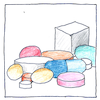John Haygarth
medicine

|
Placebo effect
Elisha Perkins patented his metallic “tractors” for the extraction of “the noxious electrical fluid” that, he said, “lay at the root of suffering.” Perkins passed the points of three-inch tapered metallic rods over the part of the body in pain for about twenty minutes and claimed a great many cures— inflammation, rheumatism, and pain in the head. Could it have been his rods were made of an exotic magical metal alloy? Perkins didn’t admit they were made of steel and brass. John Haygarth compared the efficacy of Perkins tractors with similar wooden rods and found the wooden rods worked just as well, showing “what powerful influence upon diseases is produced by mere imagination.”
Believing
Real pain is not worse than imaginary pain. Even fake medicine, administered with reassurance, can hit the spot. Believing that it helps helps. It’s good scientific practice to test a placebo as a control. A new drug or practice must do better than imagination.
Sugar pills
The effect of vitamin S is nearly indistinguishable. If it makes you happy, it’s good for you. A good bedside manner enhances any therapy. We try to say things to attract potential clients. Give the price without options; never describe the worst case. A ready aphorism can stand in for wisdom.
Think positive!
At our bus stop my friend would put his finger in the air and say “Think positive!” and then our bus would come on time. Jogging, yoga, meditation, prayer, fortune telling, whatever rocks your boat, but then don’t you wonder what it is? Are people happy because they’re lucky? want it? deserve it? work hard? walk on the sunny side? or take the pill, bitter or sweet?



We don’t say exactly that fake medicines don’t work; we say that their effects are not caused by their active ingredients.
See also in The book of science:
Readings in wikipedia: